Intel's 10nm Cannon Lake and Core i3-8121U Deep Dive Review
by Ian Cutress on January 25, 2019 10:30 AM ESTStock CPU Performance: Encoding Tests
With the rise of streaming, vlogs, and video content as a whole, encoding and transcoding tests are becoming ever more important. Not only are more home users and gamers needing to convert video files into something more manageable, for streaming or archival purposes, but the servers that manage the output also manage around data and log files with compression and decompression. Our encoding tasks are focused around these important scenarios, with input from the community for the best implementation of real-world testing.
All of our benchmark results can also be found in our benchmark engine, Bench.
Handbrake 1.1.0: Streaming and Archival Video Transcoding
A popular open source tool, Handbrake is the anything-to-anything video conversion software that a number of people use as a reference point. The danger is always on version numbers and optimization, for example the latest versions of the software can take advantage of AVX-512 and OpenCL to accelerate certain types of transcoding and algorithms. The version we use here is a pure CPU play, with common transcoding variations.
We have split Handbrake up into several tests, using a Logitech C920 1080p60 native webcam recording (essentially a streamer recording), and convert them into two types of streaming formats and one for archival. The output settings used are:
- 720p60 at 6000 kbps constant bit rate, fast setting, high profile
- 1080p60 at 3500 kbps constant bit rate, faster setting, main profile
- 1080p60 HEVC at 3500 kbps variable bit rate, fast setting, main profile

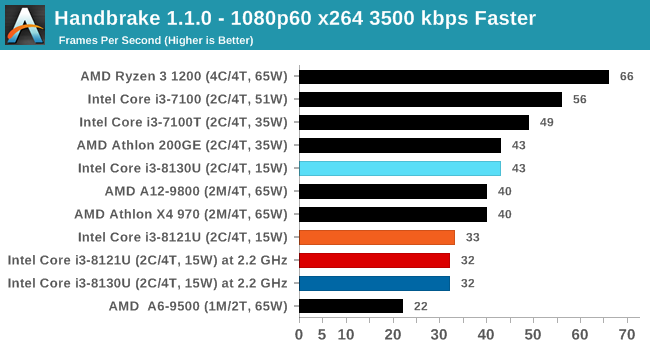
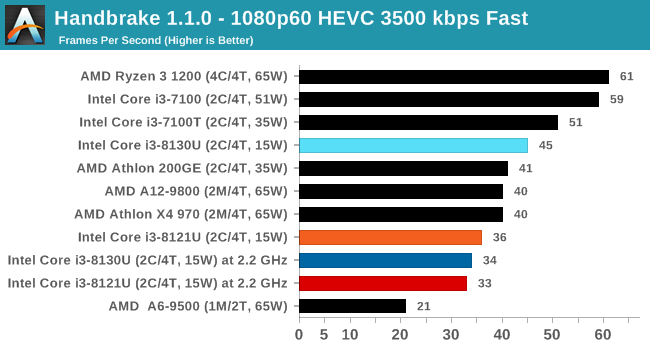
7-zip v1805: Popular Open-Source Encoding Engine
Out of our compression/decompression tool tests, 7-zip is the most requested and comes with a built-in benchmark. For our test suite, we’ve pulled the latest version of the software and we run the benchmark from the command line, reporting the compression, decompression, and a combined score.
It is noted in this benchmark that the latest multi-die processors have very bi-modal performance between compression and decompression, performing well in one and badly in the other. There are also discussions around how the Windows Scheduler is implementing every thread. As we get more results, it will be interesting to see how this plays out.
Please note, if you plan to share out the Compression graph, please include the Decompression one. Otherwise you’re only presenting half a picture.
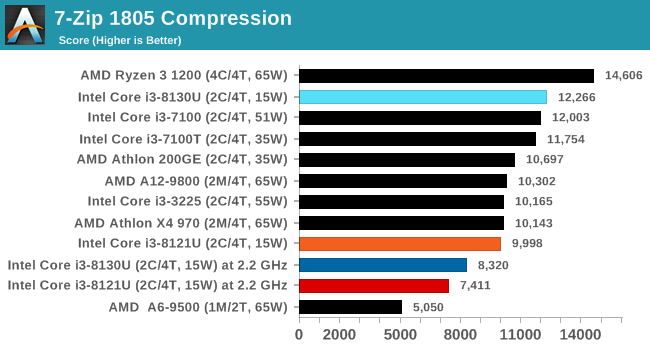


WinRAR 5.60b3: Archiving Tool
My compression tool of choice is often WinRAR, having been one of the first tools a number of my generation used over two decades ago. The interface has not changed much, although the integration with Windows right click commands is always a plus. It has no in-built test, so we run a compression over a set directory containing over thirty 60-second video files and 2000 small web-based files at a normal compression rate.
WinRAR is variable threaded but also susceptible to caching, so in our test we run it 10 times and take the average of the last five, leaving the test purely for raw CPU compute performance.
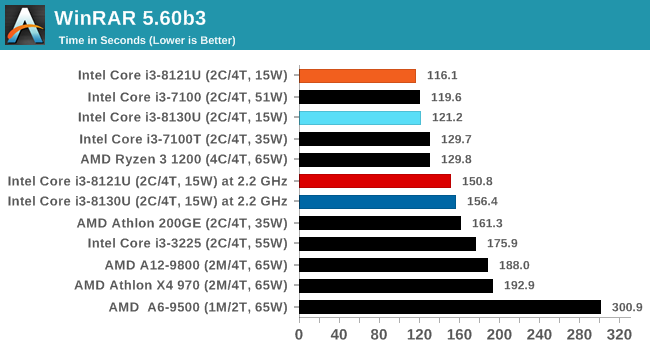
AES Encryption: File Security
A number of platforms, particularly mobile devices, are now offering encryption by default with file systems in order to protect the contents. Windows based devices have these options as well, often applied by BitLocker or third-party software. In our AES encryption test, we used the discontinued TrueCrypt for its built-in benchmark, which tests several encryption algorithms directly in memory.
The data we take for this test is the combined AES encrypt/decrypt performance, measured in gigabytes per second. The software does use AES commands for processors that offer hardware selection, however not AVX-512.
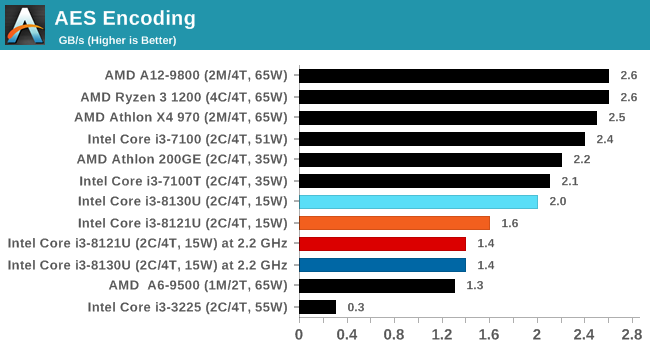










129 Comments
View All Comments
0ldman79 - Friday, January 25, 2019 - link
This whole situation begs the question, what could Intel have gotten out of 65nm, 32nm, 22nm, etc, had they run it for five generations.I wonder if they'll do similarly on the 10nm process, punt the first time or two then knock it out of the park. Skylake was a beautiful success. Maybe Sunny Cove will be the same for 10nm.
StrangerGuy - Friday, January 25, 2019 - link
The point is Intel now needs better uarch designers lot more than process designers. Yes 10nm improvements is hard work and an interesting read...but for users they ultimately only care about end performance and perf/$, not die sizes, transistors/mm2 or manufacturing margins. If Zen 2 blows the doors off CFL would anybody even care about about Intel's process advantage? Hell not.KOneJ - Sunday, January 27, 2019 - link
Doubt this is even an "if" at this point. Curious to see if *Cove cores can keep Zen 4 and later from running away too much. Only time will tell, but Intel bringing in guys like Keller can't possibly be a bad thing. And in spite of their disastrous former attempts at building a dGPU, I fully expect Intel to make it happen this go around.eva02langley - Sunday, January 27, 2019 - link
The problem is, do you believe 7nm would be any different? Unless they implement EUV directly, I don't see it. Intel will be force, like AMD, to go fab less because their node will not be better than the competition. To add to it, it is most likely be behind in time to.zodiacfml - Saturday, January 26, 2019 - link
Great job again though it doesn't warrant it for this Intel junk. Looks like they're paying Lenovo just to use Cannon lake, usable chips that came from tuning manufacturing.The performance is where I expected it to be.
I still stand to my theory that Intel is reluctant to spend, leaving their engineers stressing if they can produce 10nm products without new equipment.
Anyways, it is a dead horse. AMD will be all the rage for 2019.
KOneJ - Sunday, January 27, 2019 - link
"Intel is reluctant to spend"To the contrary: throwing money at the problem is exactly what they're doing. Have you tracked their CAPEX these past few years?
"AMD will be all the rage for 2019."
I think that's basically a given.
zodiacfml - Sunday, January 27, 2019 - link
The reports were pretty vague and I don't remember them spending substantial money except the news that they're spending for more capacity on 14nm.AMD is pretty lukewarm for me last year. I'm certain that this year will be a lot stronger for AMD until Intel and Nvidia starts taking their customers more seriously.
KOneJ - Sunday, January 27, 2019 - link
Even for a company Intel's size, spending north of $12B a year isn't penny-pinching. I know their revenue and margins are massive, but their failings haven't been a lack of spending since SB. They've been progressively spending more than ever.YoloPascual - Saturday, January 26, 2019 - link
bUt 10nm iNtEL iS bEtTeR tHaN 7nm TSMC riGhT?KOneJ - Sunday, January 27, 2019 - link
Shouldn't your alias be yOlOpAsCuAl, wannabe troll?